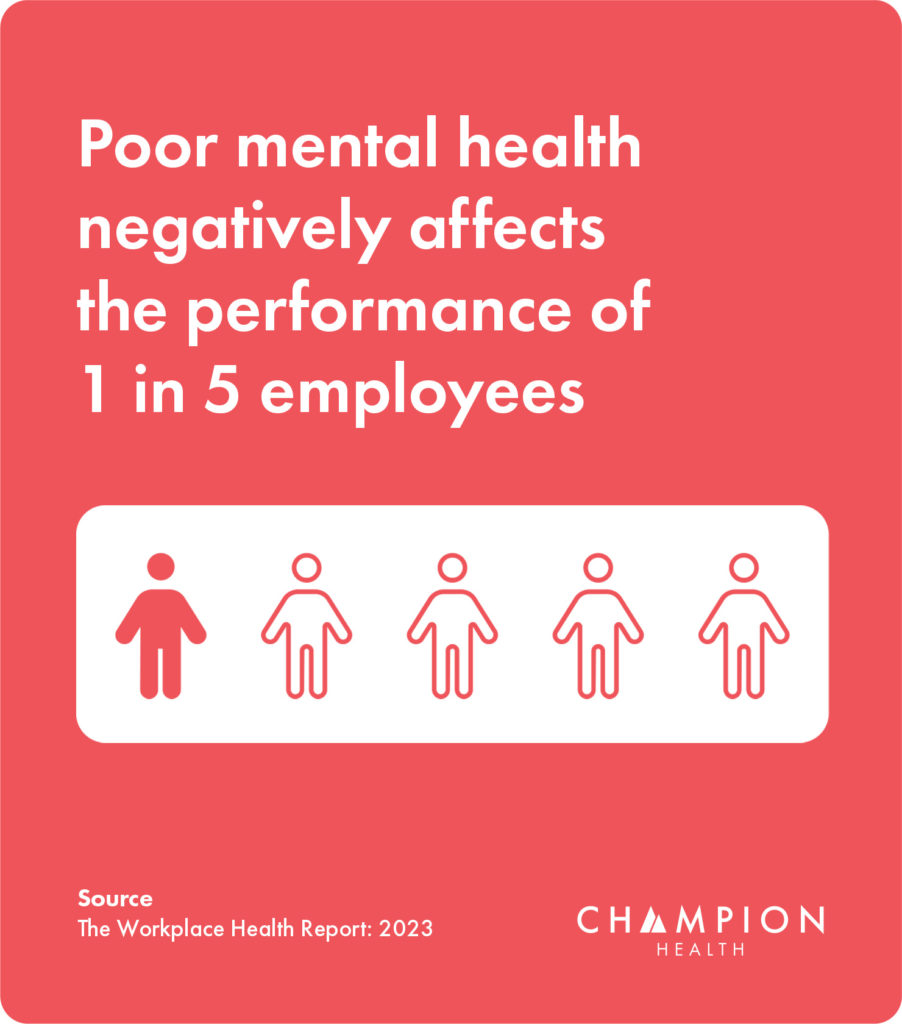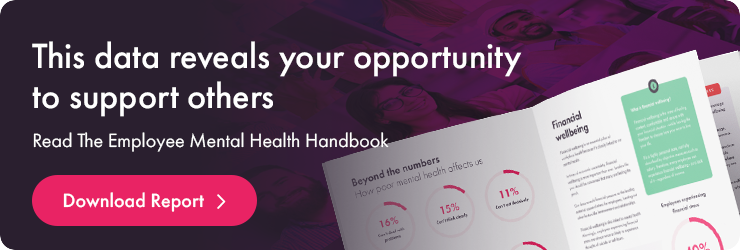Mental wellbeing is everyone’s business, quite literally.
Almost every area of health affects our daily performance levels. The same is true for mental health; if your employees are struggling and unhappy, they’re going to be less productive. But anecdotal evidence isn’t enough; let’s take a look at some of the facts.
Read on to discover:
- The financial cost of poor mental health
- Three key areas of cost to your organisation
- The return on mental health investment
- How to maximise your return on mental health investment
- Integral to the performance of your business
The financial cost of poor mental health
Early in 2020, Deloitte published their flagship report on mental health and wellbeing in the workplace. This report, called ‘Refreshing the Case for Investment’, pulled together gold-standard research papers on workplace mental health initiatives into one user-friendly space.
The report focused on UK-based organisations, but no doubt the findings I’m about to share translate across the globe.
As expected, the results collated were pretty damning towards workplace health as it currently stands. And for me, it highlighted how proactive initiatives are a ‘no brainer’ decision for every organisation, of every size, in every sector. Let me explain.
Firstly, the report looked at the average cost of poor mental health in each sector. This cost worked out at £1,652 per employee per year in the private sector, rising to £1,716 in the public sector.
Let’s put that into context. For an organisation in the financial industry with 1,000 members of staff, the average cost of poor mental health works out at £3,245 per employee. Now, this might not seem like much, but across the year, this would cost the organisation just over 3.2 million pounds.
This sounds ridiculous, doesn’t it?
Okay, so maybe you don’t have 1,000 employees, and you’re in the transport sector rather than finance… but the cost of poor mental health is a significant one to bear, and it’s only increasing every year. Can you afford not to do anything about it?
Three key areas of cost to your organisation
So now you know what the cost of poor mental health is, but where is it coming from?
Many of these costs are hidden, in all kinds of nooks and crannies across your organisation. But the research highlights three areas in particular where poor mental health will cost your business.
- Absence
- Presenteeism
- Staff Turnover
Read on to explore each of these costs in more detail.
1. Absence
Firstly, the most transparent cost of poor mental health is absence. A third of organisations report mental ill health among their top three causes of short-term absence – according to the CIPD Health and Wellbeing at Work report.
In addition, XpertHR’s 14th annual survey found that the average cost of sickness absence in 2019 was a massive £568 per employee. The same report also outlined that this figure is unlikely to show the true scale of absence; 42% of employers said they did not know if their absence cost data was accurate or not.
It remains striking how much HR and employers may be underestimating the total cost of their staff absence.
2. Presenteeism
Absence is an easy metric to measure. However, only a small proportion of your workforce will be off absent at any one time. So although this is a common cost of poor mental health, it’s not the main one.
Much higher is the cost of presenteeism.
If your employees are unhappy, they’re not going to work at their best. To make matters worse, many of your employees won’t take the time away from work they need. This is known as presenteeism: employees that need a break but do not take one.
Our own research found that poor mental health is contributing to high levels of presenteeism, with 1 in 5 employees reporting that poor mental wellbeing affects their productivity.

Presenteeism is extremely hard to detect, measure and act upon, making it extremely costly for businesses. In the long term this can have a higher cost on your business than absence. Employees reporting to work with poor health are costing you four times as much as employee absence, found Deloitte.
3. Staff turnover
Put simply: if your employees are unhappy with the business and do not feel supported, they are more likely to leave.
As you’ll already know, staff turnover is costly, particularly when taking recruitment fees, onboarding and training into account. Oxford Economics estimate the average cost to train and replace an employee that’s earning over £25,000 per year is just over £30,000.
If you replace three employees on this wage over one year, you’ll cost your business more than £90,000. The hard truth is you sometimes have to let staff go, but by protecting the mental health of your employees, you’ll reduce your level of turnover and make huge savings. And, of course, supporting your employees is the right thing to do.
The return on mental health investment
Unsurprisingly, workplace health initiatives provide a significant return on investment for the organisation, if invested wisely. The average return on investment for workplace mental health initiatives has risen from 400% in 2017 to 500% in 2020.
Again, let that sink in.
For every £10,000 invested in mental health initiatives, on average this will return £50,000.
Now for smaller organisations, it might be more reasonable to invest £1,000, or for larger ones it could be up to 100,000… but the same principle applies. On average, you’re not likely to just get your money back. You’re likely to get it back multiple times over.
How to maximise your return on mental health investment
I know that budgets are tight and wellbeing initiatives, like any cost, have to show a return on investment.
With that in mind, here are 3 key rules to maximising your return:
- Rule number 1: You need data on the specific areas that require investment
- Rule number 2: Use this data to develop a proactive health and wellbeing strategy
- Rule number 3: Ensure your strategy focuses on prevention and intervention at the heart of it
Without following these three simple rules, you run the danger of reacting to issues when it’s too late or, even worse, misallocating resources to the areas that don’t require attention… and missing the areas that do.
The Deloitte data backs this up further. Initiatives that used data through an online health assessment at the start of their wellbeing programme had a return on investment of up to 10:1. That means for every £1 invested, £10 was returned.
And initiatives that focused on being proactive rather than reactive had a return on investment that was 66% greater on average. Proactive interventions include seminars, workouts and mindfulness programmes. Reactive interventions, on the other hand, include Employee Assistance Programmes or physiotherapy services.
A case in point is Unilever’s wellbeing programme. The department had 500 members of staff, and the cost of the intervention was £80 per employee…working out at £40,000 across the year. They performed a health assessment to initially gather the data, and off the back of it, built a proactive strategy that included tailored seminars and interventions to address the relevant issues.
This returned a whopping £347,000 in just one year… £277,000 of which was from reducing presenteeism costs.
Integral to the performance of your business
The mental wellbeing of your employees really is integral to the performance of your business.
The costs of poor mental health are now well documented for every industry, and so use statistics like those from Deloitte to underpin your rationale when presenting the business case.
And remember, to maximise your return on investment, use real data from your employees and act upon it by developing a proactive strategy, focusing on prevention and early intervention.






